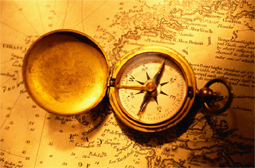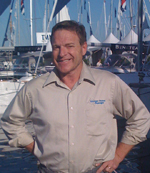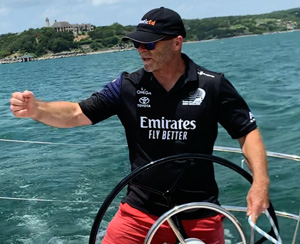NauticEd Navigator gives you personalized
course recommendations based on your
sailing goals and experience
Chart a Course to Your Sailing Future
 Select my goals
Select my goals NauticEd Navigator gives you personalized
course recommendations based on your
sailing goals and experience
 Select my goals
Select my goals
The Coastal Navigation Course offers sailors and powerboaters the opportunity to develop crucial navigation skills for operating in unfamiliar waters, both inland and near coastal areas. Covering essential topics such as chart interpretation, course-plotting, and understanding wind, tides, and currents – this comprehensive course equips all boaters with the knowledge and skills needed for safe and efficient navigation. Suitable for sailors and powerboaters of all levels, from beginners to experienced, this course is essential for those seeking to enhance their boating knowledge and become competent navigators.
Enroll today to begin your journey toward mastering coastal navigation.
Estimated Time: 10 hours
Price: $39 (or $33 with the Bareboat Charter Master Sailboat Bundle or Bareboat Charter Master Powerboat Bundle)
Enroll today to master your knowledge of coastal navigation.
Register for the Coastal Navigation Course online course and gain essential navigation skills for all sailors operating away from familiar waters, both inland and near coastal.
This comprehensive course covers all the necessary knowledge and skills you need to navigate the inland and near coastal waters safely and efficiently. From understanding charts and plotting a course to interpreting rate and direction from wind, tides, and current - this course will provide you with the skills and knowledge necessary to navigate through unfamiliar waters.
Whether you are a beginner or an experienced sailor or powerboater, this course is a must for anyone looking to expand their sailing knowledge and become a confident navigator and competent boater. Enroll now and take the first step towards mastering the art of coastal navigation.
We guarantee both your satisfaction AND Lifetime access to any boating course you buy from us.
(Note this is a real chart-based course. You will need the Long Island Sound chart and your own plotting tools. The chart you can buy online for approximately $15. If you have your own plotting tools you can use those. Alternatively, you can download the chart yourself for free and take it to a print store or you can get the full navigation pack ($39) from Amazon which contains the chart, a rotating protractor-plotter, and a set of compass dividers. Full details are listed in the course.
If you are considering this course you should also consider our Electronic Navigation course. Both courses combined provide fundamental sailing navigation while also giving you knowledge of how to best use today's hi-tech tools. Electronic Navigation is FREE with the Bareboat Charter Master Sailboat Bundle and Captain Bundle of courses, or only $14 with the Bareboat Charter Master Powerboat Bundle.
This Coastal Navigation Course is quite possibly one of the best values on the Internet. For just $39, you will fully understand the fundamentals of Coastal Navigation and be able to practically apply them wherever you go. The Course will take you about 10 hours to complete including the test. Upon completion, you will immediately receive the NauticEd Coastal Navigation Proficiency Certificate.
Register for the NauticEd Coastal Navigation Course now and impress your friends with your knowledge!
Foreword by Captain Grant Headifen. Enough years ago, so that this story can be attributed to youth rather than present-day embarrassment, we set off from St. Bart's in the Caribbean to St. Eustatius. While most islands in the Caribbean can be navigated by a line of sight, with this passage, St Eustatius is over the horizon so proper navigation techniques were required.
This was my first Chartering experience and as Captain, I was responsible for 6 crewmembers' lives and, of course, the vessel. A quick check of the charts revealed that St Eustatius was slightly west of a due south heading and was about 25 miles away - at 6 knots that would take us about 4 and a bit hours. Simple enough. Up anchor and hoist sails. Yet three times in 1/2 an hour increments something inside me was questioning my rudimentary assessment of the navigation ease. Finally, on the third visit to the charts, I spotted the compass rose and thus the source of my anxiety. At that position on the planet, the difference between the chart's definition of north and the compass reading of north is different by nearly 15 degrees.
 Whoops! A simple but amateurish mistake. Time to get serious. Now more skillful techniques had to be called upon. A new and real position had to be calculated based on the 1.5 hours of incorrect heading and the average maintained speed. Then a new plot direction had to be established for St. Eustatius based on our newly determined position. To double confirm that newly determined position I triangulated our position by taking compass shots off various islands. Back on track, we thoroughly enjoyed the rest of our vacation with a lesson never to be forgotten!
Whoops! A simple but amateurish mistake. Time to get serious. Now more skillful techniques had to be called upon. A new and real position had to be calculated based on the 1.5 hours of incorrect heading and the average maintained speed. Then a new plot direction had to be established for St. Eustatius based on our newly determined position. To double confirm that newly determined position I triangulated our position by taking compass shots off various islands. Back on track, we thoroughly enjoyed the rest of our vacation with a lesson never to be forgotten!
Such amateurish mistakes can lead to serious consequences. What if there had been a reef on our mistaken course? Get the picture?
Captain Ed Mapes' Coastal Navigation Course, as you'll discover, is one of those "oh durh could have had a V8" moments because of his reduction of the seemingly intimidating world of marine navigation to an exciting understanding and confidence in your knowledge to now - Navigate. He has turned intimidation to inclination. Inclination to get out and really practice and use your new skills.
You'll leave this Coastal Navigation Course with an understanding of:
You'll then run through real exercises to build your confidence. In the first Module, we'll introduce you to Landfall Navigation where you can mail order globally ($10 +S&H) a practice chart for the confidence-building exercises and the test. The test grades are in real-time - so that once you've passed - you'll have your Navigation Certification in hand immediately.
Register for the NauticEd Coastal Navigation Course now and as an incredibly FUN BONUS, we'll give you a GPS treasure hunt formula that you can use to set up in your neighborhood park for an enjoyable family and friends navigation picnic. Remember, with NauticEd, you can return as many times as you like to brush up on your navigation skills for FREE.
There are possibly only a few things more fun than scooting along the ocean taking compass sights off islands using dead reckoning and running fix skills to determine your position and then calculating your ETA. One of those things is actually meeting your ETA, then celebrating with a cold drink and your feet in the sand.
Please enjoy Captain Ed Mapes' Coastal Navigation Course. As with all NauticEd online sailing and powerboating lessons, if you don't feel as though you received the value for this Coastal Navigation course, then we'll simply refund your $39 investment back to you. With thousands of happy NauticEd students, however, we doubt that will happen.
If you still have questions about NauticEd Sailing School, the courses, and/or the sailing certifications, contact us via email or phone, we're happy to help.

By Ed Mapes
USCG Captain Master Mariner

By Grant Headifen
NauticEd Global Director of Education
View Coastal Navigation Course excerpt
Very informative
So much really good data. This is NOT an easy course to work through but it is very useful and I personally found it incredibly interesting and enjoyed really learning this material. I feel much better about my own abilities and knowledge as a result of this and all of the Nautic Ed courses. I fully intend to do more training and learning with Nautic Ed and look forward to some time in the virtual reality as well as in person practical training with Grant and his team Incredibly helpful and thank you all!
It was very complete
I learned a so much! The course is a significant investment of time (about 10 hours), but worth it. You will do lots of repetitions of position fixes, course plots, current calculations, etc. This is necessary to really grasp the material, which is very well presented.
Very informative.
Wasn't aware of how "electronics" dependent I was until I had to do it myself. Lot to learn!
Good material
This is a very difficult course, one that I continue go back to. It is a must if your want to coastal cruise. Detailed well explained theory and concepts. Best of all was Grant got back to me on any and all questions (even though he continues to call me James instead of my preferred name JIM)
You'll (ideally) need Chart# 12354 for this course; information that would be handy in the course description before ordering. This is a solid course, though, covering all of the major methods to get a fix using a nautical chart and observations on the water; and covering all of the nautical math to convert TVMDC numbers. The exam from the course's final module is a make-believe chart with a single starting point and a single endpoint. The questions come in the form of "if your boatspeed was X and the current was Y, how long would it take you to arrive at your destination and what would your Course To Steer be?" It's a very practical exam, designed to refine the fundamental skills covered in this course. To take the final exam you'll need either (option 1) a printer and a protractor; of (option 2) screenshot the plotting sheet; put that into PowerPoint; find an image of a protractor online and import that into PowerPoint; and use Shape Format Properties to set custom line lengths in PowerPoint; then use that to draw your current triangles. You have to be fairly adept at PowerPoint for the Option 2 method. I tried using Visio but I couldn't make it work. So, be aware that you'll likely need a printer and a protractor to successfully complete this course.
This was the hardest course for me but really pushed me to understand the basics of compass based navigation.
Hands-on exercises
Lots of great info and opportunity to learn
Question:-
You are sailing along on a heading of 57° psc (61° Mag) (47° T), and your knot meter reads 5 knots. You are passing Horton Point Light to your starboard. At 1548, a handheld bearing shows that the bearing to Horton Point Light is 119°Mag (105°T). You decide to do a running fix. At 1615, the bearing to Horton Point Light is 160°M (146°T). Determine your running fix position.
Solution:
Watch the animation then read the text then watch the animation again.
The time elapsed is
1615 minus 1548
Or
1575 -1548 = 27 minutes (/60) = .45 hours
At 5 knots you will travel 5 x 0.45 = 2.25 NM
You draw the true bearing line of 105° T to Horton Point Light. You then draw a vector 2.25NM long in the direction of your heading 47° T starting anywhere on the 105° line. You then draw another line parallel to the first 105° T bearing that intersects the endpoint of the 2.25NM vector. Finally, you draw in your second bearing line of 146° T. Where the 146° T line intersects the parallel 105° T line - you mark it as your running fix position.
The theory behind this is simple but not usually explained. Initially, you must lie on the 105-degree line somewhere but you don't know where. You know that over the time elapsed, you will travel the 2.25 NM from somewhere off the initial 105-degree line but you don't know where - yet. The parallel 105-degree line projected forward means that you will also lie somewhere on that projected line - again -somewhere. By doing the second bearing - off any object - the intersection of that bearing with the projected line means you must be at that point (given that your speed and heading were accurate).
Answer - LAT 41° 06.1' N and LONG 72° 27.0'W
At MIT's sailing program, we use the NauticEd Skipper course to make sure everybody gets a good understanding of the fundamentals before taking practical classes. It's a great timesaver and lets the sailors learn the classroom material at their own pace.